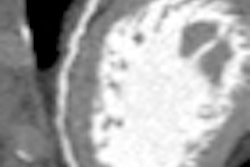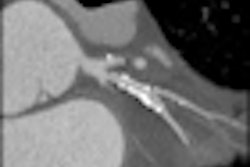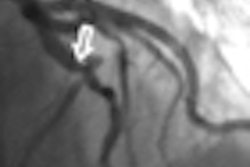CT is a strong predictor of cardiovascular events in symptomatic subjects, according to a meta-analysis conducted by German researchers and presented at the recent International Society for Computed Tomography (ISCT) meeting in San Francisco.
A growing body of evidence has demonstrated the value of coronary CT angiography (CTA) as an accurate, noninvasive modality to detect coronary artery stenoses and plaque, as well as predict future cardiac events. However, the small sample sizes used in many studies have limited their impact on public health policy, according to Dr. Hans-Christoph Becker and colleagues from Ludwig Maximilian University in Munich.
What's more, evidence from individual studies is limited by large uncertainty around individual risk estimates. The actual risk associated with specific findings in coronary CTA remains largely unclear, but it is necessary to design future outcome studies to include risk modification in prospective, randomized intervention trials and consider the public health impact, Becker said.
Becker and colleagues performed a systematic review of studies that assessed the prognostic value of coronary CTA findings on a combined cardiovascular end point, and pooled the available evidence in a meta-analysis they recently published in the Journal of the American College of Cardiology (14 June 2011, Vol. 57:24, pp. 2426-2436). Lead author on the paper was Dr. Fabian Bamberg of Ludwig Maximilian.
The researchers were particularly interested in studies that enrolled more than 100 patients who were followed for more than one year and were scanned with CT systems of 64 slices or higher or with electron-beam CT. Included studies reported a hazard ratio equal to 1.0 or greater.
After searching PubMed, Embase, and the Cochrane Library, the researchers included 11 studies involving 7,335 participants. The presence of more than one significant coronary stenosis was found in nine studies with 252 outcome events (6.8%) and 62% revascularizations. This created an annualized event rate of 11.9%. The corresponding hazard ratio was 10.74 and 6.15 in studies excluding revascularization.
In a subset of six studies with 4,733 patients with the secondary end point of any evidence of atherosclerotic plaque, the adverse outcome rate was 5%, and the hazard ratio was 4.51, which converts into an annualized event rate of about 4%.
This is the first study combining available evidence on the predictive value of coronary CTA in a comprehensive analysis of the associated risks and identifying sources of heterogeneity of the existing data, Becker and colleagues wrote in their study.
"These data may be particularly relevant to homogenize reporting standards for cardiac CT, to determine appropriate design of prospective randomized trials for risk modification on the basis of cardiac CT findings, and to estimate the potential impact of noninvasive CT imaging on healthcare systems," they wrote.
The results indicate CT-based findings of coronary plaque and stenosis are strong independent predictors of future cardiovascular events, Becker said at the ISCT conference.
The presence of significant coronary stenosis was associated with a tenfold higher risk for all cardiovascular events and a sixfold risk for death and unstable angina requiring hospitalization independent of coronary artery calcification, the researchers wrote in their study.
Becker pointed out during his presentation the results show there is a 4.5-fold risk associated with the presence of any coronary artery disease, and that each diseased coronary segment portends a 23% higher risk for adverse outcomes.
"Just to give you a comparison, the annual event rate that has been reported for SPECT imaging is about in the range of 5.9%," he said.
Choice of end points, classification of CT findings, study quality, and study population (age) introduced substantial heterogeneity with respect to risk prediction among existing studies. The heterogeneity among studies can be partially attributed to differences in the classification and reporting of CT findings.
The meta-analysis demonstrates that the following CT findings are associated with worse outcomes, thus should be included as standard reporting elements in clinical reports and future research studies:
- The presence of at least one coronary artery stenosis exceeding 50% diameter per patient
- The number of coronary segments containing at least one coronary artery stenosis exceeding 50% diameter
- Left main coronary artery disease
- The presence of any detectable atherosclerotic plaque (regardless of severity) per patient
- The number of segments containing any nonobstructive plaque, calcified, noncalcified, and mixed plaque (noncalcified and calcified plaque components)



















